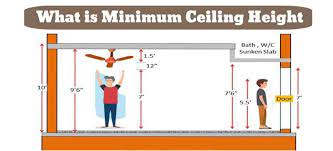If you are going to have a new house in Australia, firstly, congratulations. Secondly, have you wondered what exactly is the ceiling height of your house in Australia? And does it even meet the standard criteria for houses based in Australia? If you are not sure about the answers to these questions, you have landed in the right place. In this article, let’s see what criteria a house in Australia needs to meet, why is it necessary to meet that criteria, and what could happen if the same is not done.
The Standard Ceiling Height
Well, without beating around the bush we’ll let you know about the standards that the ceiling height of your house needs to meet. The ceiling height for habitable rooms has been declared as 2400mm (2.4 meters) by the National Construction Code in Australia. The National Construction Code is the official body responsible for setting benchmarks and standards for houses in a state. Now, if you are wondering what even is a habitable room, let us break it down for you. Places in your house like bedrooms, living room, dining room, family room, and other similar-purpose rooms are considered as “habitable rooms”.
 If there is something called habitable rooms, then surely there must be non-habitable rooms too, right? Yes, definitely! Now, the standard ceiling height for these non-habitable rooms is 2100mm (2.1 meters).
If there is something called habitable rooms, then surely there must be non-habitable rooms too, right? Yes, definitely! Now, the standard ceiling height for these non-habitable rooms is 2100mm (2.1 meters).
So, that must be clear now. 2400mm (2.4 meters) for habitable rooms and 2100mm (2.1 meters) for non-habitable rooms. But wait, why is this even a matter of importance? Okay, well let’s talk about the importance of ceiling heights now.
Importance of standard ceiling height
The universe loves diversity and hence has created all of us of different heights. Now we are sure that no tall person would like to walk into a ceiling fan the moment they step inside a room. That must give you an idea of why it is important to set a standard ceiling height for houses, or any building for that matter.

Importance of standard ceiling heights
Safety is the most obvious reason for setting standard ceiling heights. Is that about it? Well, there’s a whole list of reasons why it is important to set a standard height for the ceilings of rooms.
- Ventilation and Air Circulation: Higher ceilings allow hot air to rise and circulate, improving natural ventilation and air quality within a room. This can be particularly beneficial in warmer climates or crowded spaces where proper air circulation is vital.
- Natural Light and Illumination: Higher ceilings can accommodate larger windows and skylights, allowing more natural light to enter the room. This reduces the reliance on artificial lighting during the day, saving energy and creating a more pleasant atmosphere.
- Acoustic Properties: Ceiling height can significantly impact the acoustics of a room. Taller ceilings can help disperse sound waves more effectively, reducing echoes and reverberations, and improving the overall auditory experience.
- Design Flexibility: A standard ceiling height offers more design flexibility when choosing furniture, fixtures, and decorations. It allows for the incorporation of taller items and unique design elements without making the space feel cramped.
- Future Adaptability: Designing with standard ceiling heights ensures that the space can be easily adapted to future needs. If the ceiling is too low, it can limit the potential for modifications or renovations down the line.
What happens when standards for ceiling height are not met?
Now, this is the most important part. What happens if you fail to meet the standards required for the ceiling height in the rooms of your house? Now, of course, there’s the possibility of a tall person walking into the ceiling fan. But what else? The standards for ceiling height are important when a house evaluation is being carried out. For instance, If two of your five bedrooms are under 2.4 metres in ceiling height, your home will be deemed a three-bedroom home. Now this can have a really bad effect on the property value of your house. Not meeting the standard requirements can result in a significant decrement in the property value as potential buyers or tenants may consider the space less desirable due to its limitations.
Another issue that may arise, is the violation of the building code. How? In some jurisdictions, there are building codes and regulations that dictate minimum ceiling height requirements for certain types of spaces. Failing to meet these standards can result in code violations and may require costly modifications to bring the space up to code.
What’s the solution?
If reading all of these has troubled you with the thoughts of whether your house meets the standards or not, we recommend you hire a building inspector. Having a house inspection will resolve all of your doubts and also make sure that you don’t have to face any setbacks of not meeting the standards for ceiling heights.
FAQs
Why is there a different ceiling height for habitable and non-habitable rooms?
Habitable rooms need higher ceilings for comfort, safety, and functionality, while non-habitable rooms can have lower ceilings due to lower usage and cost considerations.
Is it necessary for all houses in Australia to adhere to the ceiling height standard?
No, it’s not necessary for all houses in Australia to adhere to the same ceiling height standard. Requirements may vary based on local building regulations.
What are the steps taken by regulatory bodies in case not found adhering to the set criteria for ceiling heights in Australia?
Fines, penalties, or stop-work orders can be imposed by regulatory bodies for not adhering to set ceiling height criteria in Australia.
What/Who is a building inspector?
A Building Inspector is a professional who inspects buildings to ensure they meet safety and code requirements.

